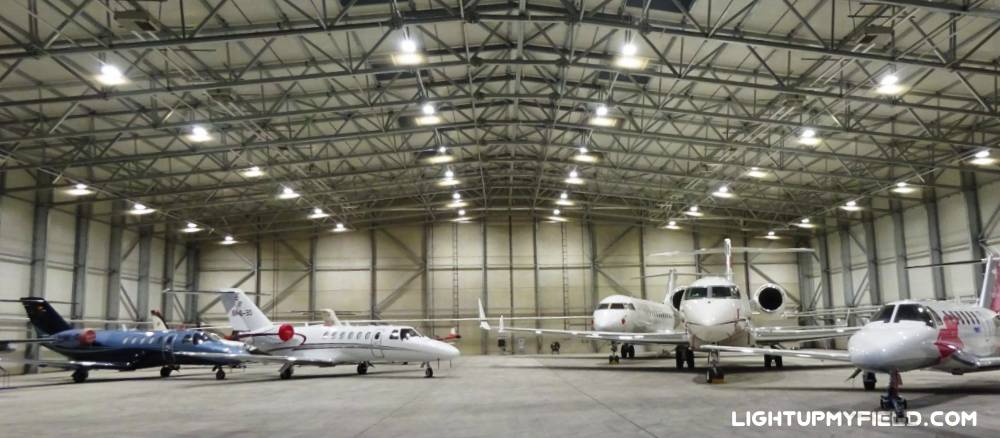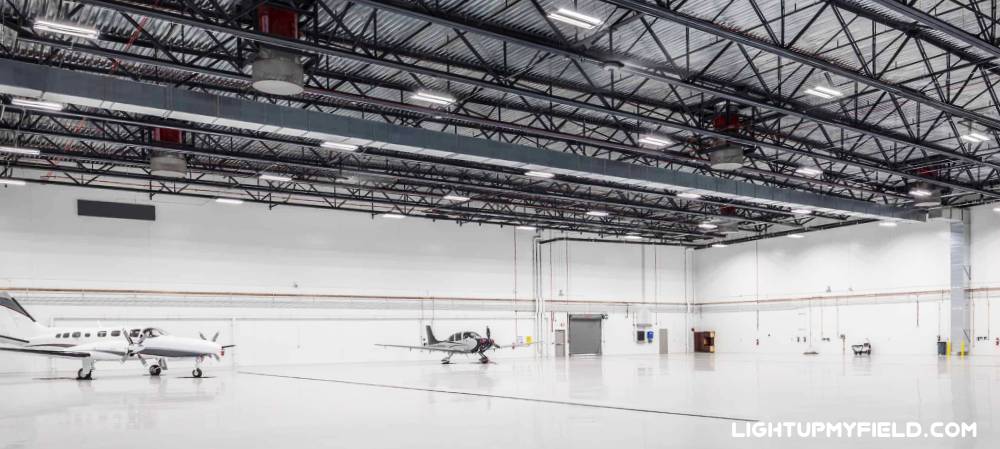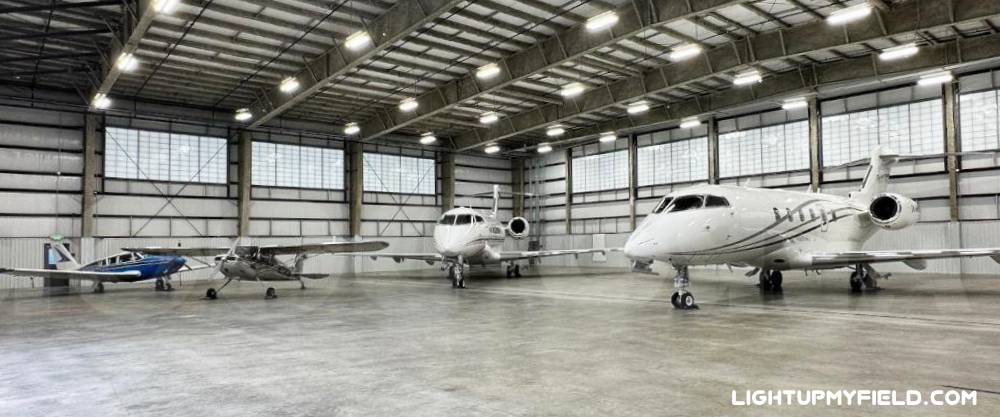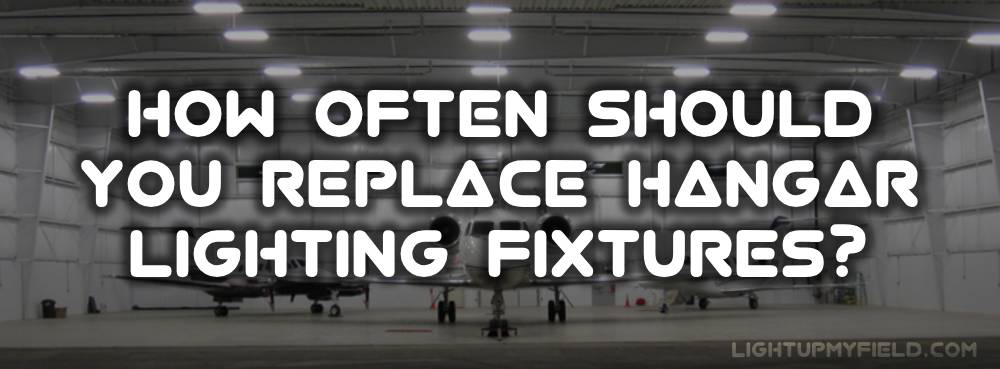Over time, the fixtures up there start to wear down, lose brightness, or just plain stop working. So, how often should you really replace those hangar lighting fixtures? It’s a question that comes up a lot, especially when balancing budget, safety, and keeping everything running smoothly. Let’s dig into why replacing is necessary, when you should do it, and what to keep in mind when making the switch.
Table of Contents
ToggleWhy Do We Need to Replace Hangar Lighting Fixtures?
You might be thinking, if the light still turns on, why bother replacing it? Well, it’s not just about whether the bulbs glow or not. Over time, lighting fixtures can start acting up in ways that are way more annoying — and sometimes risky — than just a simple outage. Flickering lights, dimming brightness, and uneven lighting coverage are all signs that your hangar lighting is past its prime.
Flickering Lights Can Be More Than Just Annoying
Flickering isn’t just irritating; it can actually mess with concentration, especially in a hangar where precision matters. Imagine trying to inspect an aircraft or handle delicate maintenance with lights that keep blinking or shifting in brightness. That kind of distraction can lead to mistakes, or worse, accidents. Plus, flickering lights might be a sign of electrical issues or aging components, which could mean safety hazards like overheating or short circuits down the line.

When the Lights Dim, So Does Productivity
Then there’s the dimming problem. As lighting fixtures age, particularly older ones like metal halide or fluorescent bulbs, their brightness fades. You might not notice the slow drop in light right away, but over months or years, it adds up. Hangars typically need around 300 to 500 lux to properly light maintenance and operational areas. When the lighting slips below those levels, your workspace gets darker, and that’s no good for anyone trying to spot small details on aircraft or equipment.
Studies show that when lighting levels drop by just 20%, productivity can take a noticeable hit, and the chances of errors go up. So, even if your hangar still looks “lit,” it might not be lit well enough. Plus, dimmer lights can contribute to eye strain and fatigue, which nobody wants on the job.
Aging Components Can Cause Safety Issues
Another thing to consider is that the internal parts of fixtures degrade over time. Ballasts in fluorescents, starters, and wiring insulation can wear out, causing inconsistent performance. This can show up as random flickers, buzzing sounds, or even complete failure of some lights. In some cases, wiring degradation could lead to overheating, posing a fire risk — definitely not something you want hanging over your head, literally.
Old Fixtures Drain Your Energy Budget
From an energy perspective, old fixtures aren’t friendly on your wallet. Metal halide and fluorescent lamps draw a lot more power than modern LEDs. For example, a typical metal halide high bay fixture can use between 400 and 1000 watts, while an LED equivalent might only pull 200 to 300 watts for the same light output. Running dozens of outdated fixtures in a large hangar can add hundreds or even thousands of dollars extra to your monthly electric bill. Over a year, that difference could be anywhere from $10,000 to $20,000, depending on how long your lights stay on.
Replacing Fixtures is About More Than Just Bulbs
So, swapping out those aging fixtures isn’t just about changing bulbs — it’s about making sure your hangar stays safe, well-lit, and more cost-effective over time. Replacing outdated lighting can dramatically reduce flicker and dimming, improve energy efficiency, and cut down on maintenance hassles. In the end, fresh fixtures mean a brighter, safer space and a healthier bottom line.

When Should We Replace Hangar Lighting Fixtures?
There’s no magic number for when to replace hangar lighting fixtures, but some general guidelines can help you figure out the right time to make a move. It really depends on the type of lighting you’re working with and how heavily it’s used.
Lifespan of Traditional Lighting Types
For older, traditional lighting like metal halide fixtures, the average lifespan usually falls between 8,000 and 15,000 hours. That sounds decent until you break it down. If your hangar lights are on for about 14 hours every day, seven days a week, you’re looking at just around a year to a year and a half before those lights start reaching the end of their useful life. After that, you’ll probably start noticing more flicker, longer warm-up times, and reduced brightness.
How Fluorescents Hold Up Over Time
Fluorescent lamps tend to last a bit longer than metal halides, typically between 15,000 and 25,000 hours. But here’s the catch — even if they haven’t fully burned out, fluorescent bulbs start to lose their brightness and shift in color temperature as they age. What that means is your hangar might still seem lit, but the quality of light will be off. Color accuracy and uniformity matter a lot when you’re dealing with aircraft maintenance or inspections, so those faded fluorescents aren’t doing you any favors.
The LED Advantage and Its Limits
LED lighting fixtures have really changed the game in terms of longevity. With rated lifespans between 50,000 and 100,000 hours, LEDs can last 8 to 15 years or more in typical hangar settings. That’s a huge jump compared to older lighting tech. However, it’s not a “set it and forget it” deal. LEDs can still have issues like dust buildup on lenses, driver failures, or occasional electrical hiccups that call for repairs or replacements before the full lifespan is up.
Watching for Signs It’s Time to Replace
The most practical way to know when to swap out your hangar lights is by keeping an eye on how well they’re performing. If you spot flickering lights, areas where the brightness has dropped below the recommended 300 to 500 lux for maintenance work, or uneven light creating annoying shadows under wings or in corners, it’s time for a closer look.
Another sneaky sign is creeping energy bills. If you’re using the same number of hours and your power costs are climbing, those aging fixtures could be working harder (and less efficiently) than they should. Replacing old lighting can help lower energy consumption, saving you money in the long run.
How to Replace Hangar Lighting Fixtures
Replacing hangar lighting isn’t as simple as swapping bulbs and hoping for the best. There’s a bit of planning and assessment involved to make sure you get the right fixtures, at the right brightness, and that everything works smoothly once installed.
What Assessment Do We Need?
Before diving into the replacement process, it’s smart to take a good look at your current lighting setup. Measuring the actual light levels with a lux meter is a great first step. This helps you identify any dark spots or areas where the light is uneven — stuff you might not notice just by eye, especially in a big hangar.
Next, think about the size and shape of your hangar. A long, narrow space might need a different layout than a wide, open floor plan. High ceilings generally call for stronger or more focused fixtures to keep the light hitting the floor at the right levels.
Checking the condition of your existing fixtures is also useful. If you’re seeing flickering lights, frequent outages, or fixtures that run hot, those are signs your current system is on its last legs. Replacing them won’t just brighten up the hangar; it’ll cut down on annoying maintenance and unexpected downtime.
The Size of the Hangar and Lux Required

The size of your hangar plays a big role in how many lights you’ll need and what kind. For example, a small 5,000-square-foot private hangar might only need about a dozen fixtures to hit the recommended light levels. On the flip side, a large commercial hangar of 50,000 square feet could need 100 fixtures or more.
Ceiling height matters too. Higher ceilings usually require high bay fixtures that push light further down, keeping those important maintenance areas lit at around 300 to 500 lux. Areas where detailed work happens demand better and more uniform lighting compared to storage or waiting zones, so expect to mix and match fixture types or add task lighting as needed.
Changing Light Type — From Metal Halide or Fluorescent to LED
Making the switch from old-school metal halide or fluorescent lighting to LED is often a no-brainer. LEDs last way longer — 50,000 to 100,000 hours versus 8,000 to 25,000 hours for older tech — and they use way less power, which translates to big savings on energy bills.
When you’re replacing older fixtures, check if your existing wiring and mounting points can handle LED upgrades. Sometimes you can retrofit LED bulbs into your current fixtures, but a full fixture replacement usually delivers better light quality and longer-term reliability.
LEDs also give you more options for things like beam angles and dimming controls. That means you can customize your hangar’s lighting setup more precisely to avoid glare, shadows, or wasted energy. Plus, LEDs generally have a better color rendering index (CRI), which helps mechanics and technicians see aircraft details clearly.
Installation Considerations — Wiring, Power Supply, and More
Don’t overlook the electrical side of things. Older hangars may have wiring or ballasts designed for metal halide or fluorescent systems that aren’t compatible with LEDs. Sometimes, you’ll need to rewire circuits or upgrade your power supply to avoid flicker, buzzing, or safety hazards. Sure, that can bump up the installation cost, but it’s worth it for smoother operation and peace of mind.
Replacing fixtures in a hangar isn’t always an easy job either. Tall ceilings mean you’ll probably need lifts or scaffolding, so factor those into your budget and schedule. Plus, if your hangar is busy, you’ll want to plan the work so it doesn’t disrupt daily operations — maybe tackling one section at a time or scheduling during slower periods.
Common Mistakes When Replacing Hangar Lights
Skipping a Proper Assessment
One of the biggest slip-ups people make is jumping straight into replacing their hangar lights without doing a proper assessment first. Without measuring your current lighting levels or considering the hangar’s size and ceiling height, you might end up with fixtures that don’t meet the necessary lux requirements or aren’t the right fit for the space. This usually means extra costs down the line — either to fix uneven lighting, add more fixtures, or both. It’s like buying shoes without trying them on first; you might regret it later.
Ignoring Electrical Compatibility
Another common pitfall is ignoring the electrical compatibility of new fixtures. Simply swapping out old bulbs for LEDs without checking the wiring, drivers, or controls can lead to problems like flickering, buzzing, or even premature failure of the lights. Plus, not upgrading things like dimmers, sensors, or smart controls means missing out on significant energy savings that modern lighting systems can offer.
Cutting Corners on Installation
Cutting corners during installation is another mistake to watch out for. Using the wrong mounting hardware or failing to secure fixtures properly doesn’t just risk the lights falling — which could cause serious damage or injury — but also affects the overall durability and performance of your system. Remember, hangar lighting fixtures are often heavy and installed way up high, so safety during installation and long after is something you don’t want to gamble with. Taking your time, using the right gear, and hiring professionals when needed will save money and stress in the long run.

